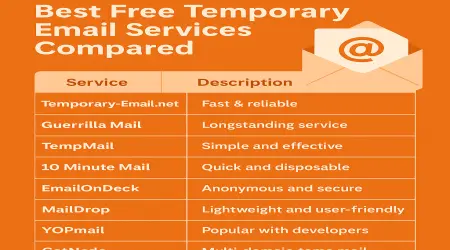

Temp Mail in 2025: The Ultimate Guide to Disposable Email and Online Privacy
Introduction
Email has become an inseparable part of our online lives. From signing up for social media platforms to purchasing products online, an email address is often required. However, sharing your permanent email everywhere exposes you to spam, data breaches, and privacy risks.
This is where Temp Mail and other disposable email services step in. By providing temporary, anonymous email addresses, these services help you navigate the internet safely and clutter‑free.
In this ultimate 2025 guide, we’ll cover everything you need to know about Temp Mail: how it works, its benefits, drawbacks, privacy concerns, best use cases, and alternatives — so you can protect your online identity more effectively than ever.
What Is Temp Mail?
Temp Mail, also called temporary mail or disposable email, is a service that provides you with a short‑term email address. Unlike traditional email (Gmail, Outlook), Temp Mail requires no registration and automatically deletes your inbox after a set period (minutes, hours, or days).
Key features:
Instant generation of email addresses
No personal data required
Automatic message expiration
Free to use on web or mobile
Why Is Temp Mail Important in 2025?
Online privacy has become more critical due to:
Rising spam levels: Over 45% of all global emails are spam in 2025.
Increased data breaches: Millions of accounts are compromised every year.
Aggressive marketing practices: Websites track your email activity for profiling.
Disposable email addresses like Temp Mail protect users from spam and data leaks, offering a simple yet effective shield against unwanted exposure.
How Does Temp Mail Work?
1. Generating the Address
When you visit a Temp Mail website or app, the system automatically creates a random email address. Example: [email protected]
2. Receiving Emails
Any email sent to this address appears in a public inbox visible only on that session/page. No login is needed.
3. Expiration
After a predefined period (10 minutes to 24 hours), the email and all messages are permanently deleted, leaving no trace.
Benefits of Using Temp Mail
1. Protect Your Main Inbox
Temp Mail ensures spam, newsletters, and promotional emails don’t reach your primary address.
2. Stay Anonymous
You don’t need to provide personal information, making it ideal for anonymous sign‑ups and testing services.
3. Fast and Free
No registration or setup required — just visit the site and get an email address instantly.
4. Reduce Data Exposure
If a platform is compromised, your permanent email isn’t affected.
5. Multiple Uses
Create unlimited disposable addresses for various sites, avoiding clutter in your main inbox.
Drawbacks and Limitations
Short Lifespan: Emails disappear after expiration — unsuitable for long‑term use.
Public Inboxes: Some services allow anyone who knows the address to see your messages.
Limited Features: No advanced storage, forwarding, or reply capabilities.
Not for Sensitive Accounts: Avoid using for banking, work, or personal communications.
Best Use Cases for Temp Mail
Quick Registrations
Use Temp Mail for one‑time sign‑ups like contests, free trials, or accessing gated content.
Testing Apps or Websites
Developers and QA testers can register accounts without cluttering personal inboxes.
Avoiding Spam
Keep spam‑prone services (e.g., newsletter popups) isolated from your permanent email.
Anonymous Browsing
Ideal for forums or platforms where privacy is paramount.
Security and Privacy Concerns
While Temp Mail enhances anonymity, users must remain cautious:
Public nature of inboxes: Anyone who knows the address can read incoming messages.
No encryption: Most disposable emails lack end‑to‑end encryption.
No recovery options: Once deleted, you can’t retrieve messages or accounts linked to them.
Tip: Never use Temp Mail for critical accounts like banking or government services.
Comparing Temp Mail to Permanent Email
| Feature | Temp Mail | Permanent Email (e.g., Gmail) |
|---|---|---|
| Privacy | High (anonymous) | Moderate (linked to identity) |
| Spam Protection | Excellent (auto‑delete) | Requires filters/rules |
| Lifespan | Short (minutes/hours) | Long‑term |
| Account Recovery | Not possible | Fully supported |
| Setup Time | Instant | Requires registration |
Alternatives to Temp Mail in 2025
1. Temporary‑Email.net
Fast, secure, and modern interface
Auto‑delete feature with private inbox
Ideal for users seeking better privacy than Yopmail
2. 10MinuteMail
Popular for ultra‑quick verifications
Adjustable lifespan beyond 10 minutes
3. Guerrilla Mail
Allows custom usernames
Spam filtering and extended email lifespan
4. Teamail (New)
Next‑generation disposable email with optional encryption
Flexible expiration settings
5. AnonAddy
Open‑source email alias service
Good for longer‑term anonymous communication
Using Temp Mail for Social Media
Many users in 2025 create secondary social media accounts for testing or marketing. Temp Mail helps by:
Avoiding spam from platforms like Facebook or Twitter
Managing multiple profiles without using personal emails
Protecting real identity when experimenting with new platforms
Caution: Some platforms block disposable emails — always check their policy.
How to Maximize Privacy with Temp Mail
Use a VPN: Combine Temp Mail with VPNs to mask your IP address.
Clear cookies: Prevent cross‑site tracking while using disposable emails.
Avoid sharing the address: Treat it like a password — share only when needed.
Check for HTTPS: Ensure the Temp Mail site is secure before entering sensitive info.
Temp Mail and the Future of Online Privacy
In 2025, privacy regulations (like GDPR and CCPA) continue to evolve, but data breaches and spam persist. Temporary email services remain vital for individuals seeking control over their digital footprint.
Emerging trends include:
Encrypted disposable emails
Custom domain temporary emails
Integration with password managers
AI‑powered spam filtering
Step‑by‑Step: How to Use Temp Mail Effectively
Visit a reputable Temp Mail provider (e.g., Temporary‑Email.net).
Copy the auto‑generated address.
Paste it into the registration or verification field.
Check the temporary inbox for confirmation emails.
Complete the sign‑up or verification.
Let the address expire — leaving no trace of your personal data.
FAQs About Temp Mail
Q: Is Temp Mail legal?
Yes. Using disposable email addresses is legal, but fraudulent or abusive activity is not.
Q: Can I send emails from Temp Mail?
Most services allow only receiving, not sending, to prevent abuse.
Q: Can I retrieve expired emails?
No. Once an email expires, it’s permanently deleted.
Q: Are there private Temp Mail services?
Yes, some offer private, encrypted options — but most are public by default.
Conclusion
Temp Mail is a simple yet powerful solution for maintaining online privacy in 2025. Whether you’re signing up for newsletters, testing apps, or avoiding spam, disposable email services offer speed, anonymity, and protection unmatched by permanent email accounts.
By combining Temp Mail with privacy best practices — like VPNs and cautious data sharing — you can enjoy the web with less spam and more control over your digital identity.
Target Keywords
Temp Mail 2025, disposable email guide, temporary email privacy, avoid spam online, anonymous email services

